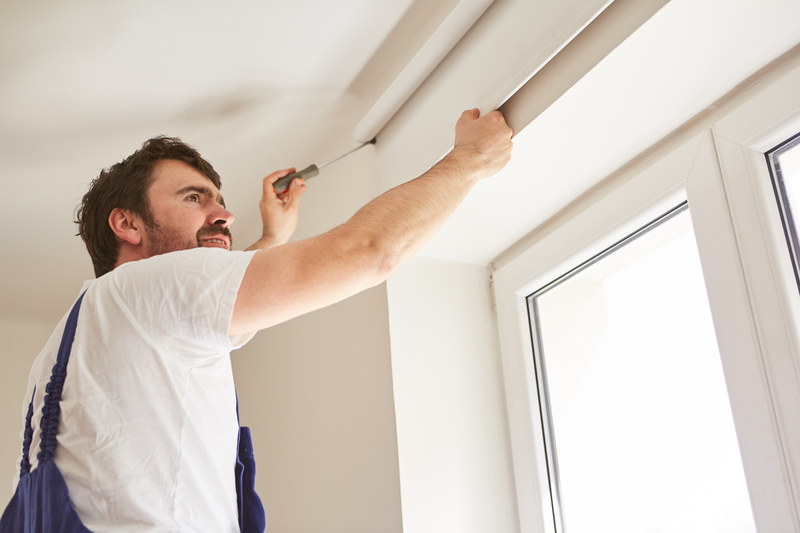Guide to DIY Blind Installation: Step-by-Step Instructions for Every Blind Type
Window blinds are a versatile and stylish addition to any home, offering privacy, light control, and a touch of elegance. But the thought of installing them yourself might seem daunting. We understand that tackling a DIY project can be intimidating, especially for beginners. That’s why we’ve broken down each installation process into easy-to-follow steps, complete with material lists and operation instructions. By the end of this guide, you’ll have the confidence to transform your windows and enhance your home’s aesthetics and functionality.
Before we dive into the specifics of each blind type, remember that safety is paramount. Always use the proper tools, follow manufacturer instructions, and install child safety devices where necessary. Let’s get started on your journey to becoming a DIY blind installation expert!
Step-by-Step DIY Blind Installation Guide | Blinds In Harmony
Types of Blinds and How Do You Install them?
When it comes to selecting the right window blinds, there are a variety of options to suit different needs and preferences. Let us explore some of the most popular blind types and step-by-step instructions on how to install them.
How to Install Roller Blinds?
Roller blinds are a popular choice for their simplicity and clean lines. They consist of a single piece of fabric that rolls up neatly around a tube at the top of the window. Installing roller blinds is generally straightforward, making them an excellent option for DIY enthusiasts of all skill levels.
Materials needed
- Roller blind (includes the blind fabric, rolling tube, and bottom bar)
- Mounting brackets (usually included with the blind)
- Screwdriver
- Drill with appropriate drill bits
- Pencil
- Tape measure
- Spirit level
- Screws (typically 4mm, suitable for your wall type)
- Wall plugs (if mounting into masonry)
- Step ladder (if necessary)
Step by Step process
- Measure and mark bracket positions:
- For inside mount: Measure and mark where you’ll place the brackets inside the window frame. Ensure they’re level.
- For outside mount: Hold the blind up to the desired position, and mark where the brackets should go, ensuring they’re level.
- Install the brackets:
- Drill pilot holes at your marks.
- If mounting into masonry, insert wall plugs.
- Screw the brackets into place.
- Insert the blind:
- With the blind fully rolled, insert the idle pin (non-control end) into its bracket.
- On the control end, depress the pin and slot it into the opposite bracket.
- Install the safety device:
- Attach the child safety device to the wall at the maximum distance from the control mechanism.
- Ensure the chain is taut when threaded through the device.
- Test the blind:
- Gently pull the chain to lower and raise the blind, ensuring smooth operation.
Operation Instructions
To lower the blind, pull the rear chain gently. To raise it, pull the front chain. Always use the chain at a vertical angle to prevent damage to the mechanism. When not in use, secure the chain in the safety device to prevent hazards to children and pets.
How to Install Venetian Blinds?
Venetian blinds offer excellent light control with their adjustable horizontal slats. They come in various materials, including aluminium, wood, and faux wood. While they may look complex, installing Venetian blinds is a manageable DIY project.
Materials needed
- Venetian blind (includes headrail with slats and bottom rail)
- Mounting brackets
- Valance clips (if included)
- Screwdriver
- Drill with appropriate drill bits
- Pencil
- Tape measure
- Spirit level
- Screws (typically 4mm, suitable for your wall type)
- Wall plugs (if mounting into masonry)
- Step ladder (if necessary)
Step by Step process
- Attach the brackets:
- For inside mount: Position brackets at least 5cm from each end of the headrail, marking their positions.
- For outside mount: Hold the blind up, mark bracket positions, ensuring they’re level.
- Drill pilot holes, insert wall plugs if necessary, and screw brackets into place.
- Install the headrail:
- Open the swing arm on each bracket.
- Slide the headrail into the brackets.
- Close the swing arms to secure the headrail.
- Attach the valance (if applicable):
- Clip the valance clips onto the headrail.
- Snap the valance into the clips.
- Install hold-down brackets:
- Mark positions for hold-down brackets at the bottom of the window.
- Drill pilot holes and screw brackets into place.
- Snap the pins on the bottom rail into the hold-down brackets.
- Install the safety cleat:
- Position the safety cleat at least 1.5m from the floor.
- Mark screw positions, drill pilot holes, and attach the cleat.
Operation Instructions
To lower or raise the blind, pull the lift cord down at an angle. To lock the blind in place, pull the cord towards the centre of the blind and release it. To tilt the slats, use the tilt cord or wand, pulling gently to adjust the angle of the slats. Always wrap excess cords around the safety cleat when not in use.
How to Install Vertical Blinds
Vertical blinds are ideal for large windows and sliding glass doors. They consist of vertical vanes that can be rotated for light control and drawn to the side for full access to the window or door.
Materials needed
- Vertical blind (includes headrail, vanes, and weights)
- Mounting brackets
- Screwdriver
- Drill with appropriate drill bits
- Pencil
- Tape measure
- Spirit level
- Screws (typically 4mm, suitable for your wall type)
- Wall plugs (if mounting into masonry)
- Step ladder (if needed)
Step by Step process
- Install the brackets:
- For inside mount: Position brackets about 5cm from each end of the headrail, marking their locations.
- For outside mount: Hold the headrail up, mark bracket positions, ensuring they’re level.
- Drill pilot holes, insert wall plugs if necessary, and screw brackets into place.
- Attach the headrail:
- Lift the headrail into position.
- For top fix: Tilt and hook one side of the headrail into the bracket, then push up until it clicks into place.
- For face fix: Hook the back of the headrail into the bracket, rotate it into position, and tighten the screw at the front of the bracket.
- Hang the vanes:
- Ensure all vane carriers are open.
- For fabric vanes: Hook each vane into its carrier.
- For PVC vanes: Slide each vane up into its carrier until it clicks.
- Install the safety device:
- Attach the cord tensioner to the wall, ensuring the cord/chain is taut.
- Test the blind:
- Draw the blind across the window and back.
- Rotate the vanes to check smooth operation.
Operation Instructions
To open or close the blinds, pull the cord to draw the vanes across the window. To rotate the vanes, twist the wand or pull gently on the beaded chain. When drawing the vertical blinds open, ensure the vanes are in the open position to prevent damage.
How to Install Commercial Blinds
Commercial blinds are designed for durability and functionality in high-traffic areas such as office space. They often come in larger sizes and may require more robust installation methods. Whilst the basic principles are similar to residential blinds, always consult the manufacturer’s specific instructions.
Materials needed
- Commercial blind (includes headrail and shade material)
- Heavy-duty mounting brackets
- Screwdriver
- Power drill with appropriate drill bits
- Pencil
- Tape measure
- Spirit level
- Heavy-duty screws (size as specified by the manufacturer)
- Wall plugs (if mounting into masonry)
- Step ladder
- Assistant (recommended for larger blinds)
Step-by-Step Process
- Prepare the mounting surface:
- Ensure the mounting surface is sturdy and can support the weight of the blind.
- For plasterboard, locate studs or use appropriate fixings.
- Install the brackets:
- Mark bracket positions, usually 10cm from each end of the headrail and every 60-90cm in between for larger blinds.
- Use a spirit level to ensure marks are even.
- Drill pilot holes and secure brackets with heavy-duty screws.
- Mount the headrail:
- With assistance, lift the headrail into position.
- Secure the headrail to the brackets according to the manufacturer’s instructions (this may involve sliding the headrail into place or using specific locking mechanisms).
- Install the shade:
- If the shade is separate from the headrail, attach it according to the product’s design (this may involve snapping it into place or using hooks or Velcro).
- Install safety devices:
- For cord-operated blinds, install cord cleats or tensioners as required by safety regulations.
- Test and adjust:
- Operate the blind several times to ensure smooth function.
- Make any necessary adjustments to ensure even rolling and proper alignment.
Operation Instructions
Operation varies depending on the specific type of commercial blind. For manual blinds, there may be a chain, crank, or cord system. Always use smooth, consistent motions when raising or lowering the blind to prevent damage. For motorised systems, follow the manufacturer’s instructions for remote control or switch operation.
How to Install Automated Blinds
Automated or motorised blinds offer convenience and can be integrated into smart home systems. Whilst the installation process of automated blinds is similar to standard blinds, there are additional steps for setting up the motor and control systems.
Materials needed
- Automated blind (includes motorised headrail and shade)
- Mounting brackets
- Screwdriver
- Drill with appropriate drill bits
- Pencil
- Tape measure
- Spirit level
- Screws (as specified by the manufacturer)
- Wall plugs (if mounting into masonry)
- Step ladder
- Electrical tools (if hardwiring is required)
- Remote control or smart hub (as provided)
Step-by-Step Process
- Plan the installation:
- Determine power source location (battery, plug-in, or hardwired).
- For hardwired installations, consult a qualified electrician.
- Install the brackets:
- Mark bracket positions, ensuring they’re level.
- Drill pilot holes and secure brackets with screws.
- Prepare the power source:
- For battery-operated blinds, insert batteries into the motor unit.
- For plug-in models, ensure a nearby socket is available.
- For hardwired models, have an electrician run wiring to the installation location.
- Mount the headrail:
- Carefully lift the motorised headrail into the brackets.
- Secure according to manufacturer’s instructions, taking care not to damage any wiring.
- Connect power:
- For plug-in or hardwired models, connect the motor to the power source.
- Ensure all connections are secure and any exposed wiring is properly concealed.
- Programme the blind:
- Follow the manufacturer’s instructions to pair the blind with its remote control or smart hub.
- Set upper and lower limits for the blind’s movement.
- Test operation:
- Use the remote or app to raise and lower the blind, ensuring smooth operation.
Operation Instructions
Automated blinds are typically operated via remote control, smartphone app, or integration with a smart home system. Consult your product’s user manual for specific instructions on programming schedules, adjusting settings, and troubleshooting. Remember to keep spare batteries on hand for battery-operated models.
How to Install Roman Blinds
Roman blinds offer a soft, elegant look with fabric that folds into neat horizontal pleats when raised. While they may look complex, installing Roman blinds is similar to other types of blinds with a few unique considerations.
Materials needed
- Roman blind (includes headrail and fabric shade)
- Mounting brackets
- Screwdriver
- Drill with appropriate drill bits
- Pencil
- Tape measure
- Spirit level
- Screws (typically 4mm, suitable for your wall type)
- Wall plugs (if mounting into masonry)
- Step ladder (if necessary)
Step by Step process
- Attach the brackets:
- For inside mount: Position brackets inside the window recess, marking their locations.
- For outside mount: Hold the blind up, and mark bracket positions, ensuring they’re level.
- Drill pilot holes, insert wall plugs if necessary, and screw brackets into place.
- Install the headrail:
- Lift the headrail into position.
- Secure the headrail to the brackets according to the manufacturer’s instructions (this may involve clicking it into place or using screws).
- Adjust the cords:
- Ensure all lift cords are evenly distributed and run smoothly through the rings on the back of the blind.
- Check that the blind hangs evenly when lowered.
- Install the safety device:
- Attach the cord cleat to the wall at a height out of reach of children.
- Wrap excess cords around the cleat when the blind is raised.
- Test the blind:
- Gently raise and lower the blind, checking for smooth operation and even folding of the fabric.
Operation Instructions
To lower the Roman blind, gently pull the cord to release the locking mechanism and allow the fabric to unfold. To raise the blind, pull the cord smoothly until the blind reaches the desired height, then move the cord slightly to the side to lock it in place. Always use the cord cleat to secure the excess cord when the blind is raised.
Safety Considerations
Child and pet safety is crucial when installing any type of window covering. Here are some important safety measures to keep in mind:
- Cord safety: Always install cord cleats or tensioners for blinds with loose cords. Keep cords out of reach of children and pets.
- Breakaway devices: Some blinds come with breakaway devices on the cords. Ensure these are properly installed.
- Motorised options: Consider motorised blinds for enhanced safety, especially in children’s rooms.
- Regular checks: Periodically inspect your blinds for any loose parts or damaged cords.
- Education: Teach children about the dangers of playing with window-covering cords.
Troubleshooting Tips
Here are some common issues you might encounter during or after installation, along with solutions:
- Uneven hanging: Check that brackets are level and the headrail is properly seated. For Roman blinds, ensure cords are evenly distributed.
- Difficulty raising/lowering: Inspect for any obstructions in the mechanism. For corded blinds, check that cords aren’t tangled.
- Slats not closing properly: Adjust the tilt mechanism according to the manufacturer’s instructions.
- Automated blinds not responding: Check power source and connections. Reprogram if necessary.
- Fabric wrinkling (Roman blinds): Steam or iron the fabric according to care instructions.
- Gaps at edges (inside mount): Consider adding side channels or opting for an outside mount for better coverage.
Remember, if you encounter persistent issues or are unsure about any step in the installation process, it’s always best to consult a professional or contact the manufacturer for guidance.
Start Your DIY Journey with Blinds In Harmony DIY
Blind installation can be a rewarding project that enhances your home’s aesthetics and functionality. By following this guide, you can successfully install various types of blinds, from simple roller blinds to more complex automated systems. Remember to prioritise accurate measurements, use the right tools, and always put safety first.
While DIY installation can be satisfying, it’s important to know when to call in the professionals, especially for complex or large-scale projects. If you’re unsure about any step in the process, don’t hesitate to seek expert advice.
At Blinds in Harmony, we offer a wide range of blinds, curtains, and fly screens to suit every style and need. We invite you to explore our gallery to discover how our high-quality blinds can transform your space. Start your window transformation journey with Blinds in Harmony today!



